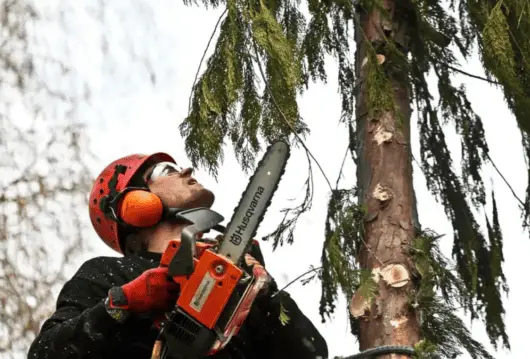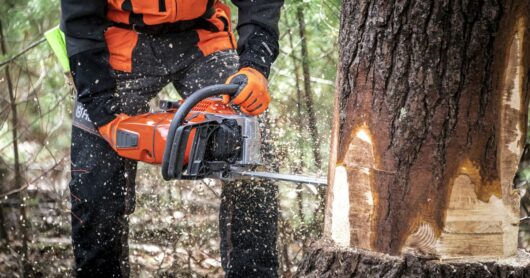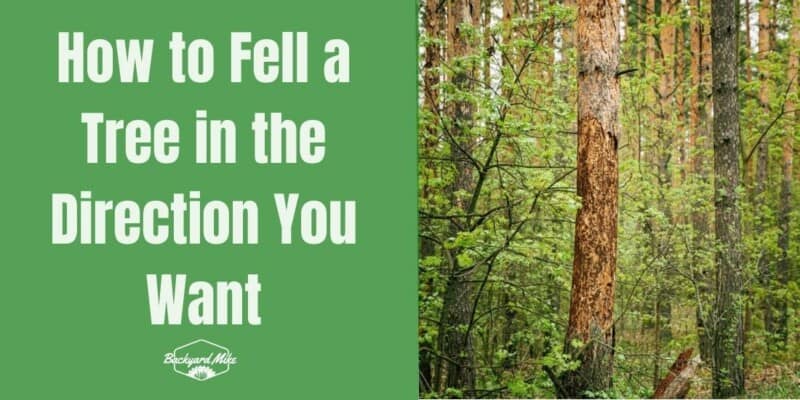Felling a tree is a process that requires skill, knowledge and safety measures. If the tree is not felled in the right direction, it can lead to property damage or injury. In this article, you will learn how to fell a tree in the direction you want, ensuring that it falls safely and as intended. Follow these simple tips, and you’ll be sure to fell a tree in the right direction every time. So, if you’re looking for advice on how to fell a tree in the direction you want, you’ve come to the right place. Read on to learn the best ways to ensure a successful felling every time.
Prioritize your safety when felling a tree
Of the potential tasks around your house and yard, some of them are appropriate for homeowners, while others require the expertise of a professional. With common sense and attention to detail, you will be able to fell a tree in the direction you want. With the right approach and a sharp chainsaw, you can fell a tree in your backyard without any issues. However, you must prioritize safety throughout the process.
Felling a tree is an extremely dangerous task. The Occupational Safety and Health Administration has reported that more people get injured and die while felling trees than during other logging activities. With that in mind, safety must be your top priority. Failure to adhere to safety protocols could end up being deadly.
When you’re using a chainsaw for felling, limbing, and bucking trees, you will have to wear the following protective safety gear –
- Helmet
- Protective chaps
- Eye and face protection
- Gloves
- Steel-toed leather boots
- Long-sleeved shirt
Further, you must also be alert and aware of the surroundings when you are operating the chainsaw.

Planning the felling direction
When it comes to felling a tree, it’ll be important that you choose the right direction to ensure safety and prevent damage to property or people. Choosing the felling direction in which you want the tree to fall would be an important decision that must be made based on different factors.
Pick a felling direction
The first step in picking the ideal felling direction would be to identify the general direction of the tree’s lean. In most cases, the tree will likely lean in the direction of the strongest side. For identifying the lean of the tree, you can begin by standing behind the tree and looking up.
Look for visible lean or tilt in the trunk or branches. If the lean isn’t visible immediately, you should look for signs of uneven growth, like lopsided branches or uneven bark. Once you have identified the general direction of the tree’s lean, you must choose the felling direction that’ll allow the tree to fall in that direction. Felling the tree in the opposite direction of the tree can be highly dangerous and cause the tree to fall unpredictably.
Consider the slope of the land
The slope of the land will be an important factor to consider when you are picking a felling direction. Felling a tree uphill will be dangerous, as the tree could gain momentum and roll back downhill. Similarly, felling a tree downhill could be hazardous, as the tree may pick up speed and result in damage or injury.
For determining the slope of the land, you can make use of a level or simple water level. Place the water or the water level on the ground before measuring the difference in height between the two ends. If the difference is significant, you must choose a felling direction that takes the slope of the land into account.
Estimate the tree’s height
Estimating the height of the tree is important when selecting the felling direction. The height of the tree will help you determine how far away the tree you must stand while felling it. For estimating the height of the tree, you can make use of a few simple techniques.
One common method would be to use a stick and measure the length of the shadow it casts at the same time of the day as you intend to fell the tree. After that, measure the height of the stick and use the ratio of the shadow length to the stick height for estimating the height of the tree.
Another method would be to use a clinometer, which is a tool used for measuring angles. You can make use of the clinometer for measuring the angle between your eye level and the top of the tree. Once you’ve got the angle, you can use simple trigonometry for estimating the height of the tree.
Marking the tree
Marking the tree is a crucial first step when preparing for the felling operation. You will have to start at the top of the tree, mark the bottom of the tree, mark the back cut, and mark the wedge cuts to make sure you can fell a tree safely and accurately. Further, you should also make sure that you’re marking an escape path so that you don’t get into any accident if the tree falls unexpectedly.
Start at the top of the tree
Before you mark the top, you must take note of any branches or obstructions that might impact the fall path of the tree. Start off at the highest point of the tree, and then identify the direction in which you want the tree to fall. This is known as the felling direction.
Marking the bottom of the tree
Once the felling direction is established, you must mark the base of the tree or stump with chalk or spray paint. This mark needs to be visible and easy to follow. Doing so will make it easier to carry out the felling process.
Marking the back cut
The back cut is a horizontal cut that is made opposite the felling direction. It must be made around one-third of the way through the trunk of the tree. For marking the back cut, you must measure the tree’s diameter at chest height and divide it by two. Now, make a horizontal mark on the back of the tree.
Marking the wedge cuts
Wedge cuts are used for directing the fall of the tree. They’re made on the side of the tree opposite the back cut, slightly above the level of the back cut. For marking the wedge cuts, you must make two vertical marks, one at the top of the back cut and the other at the base of the tree, at a 90° angle to the felling direction. These marks need to be connected by a diagonal line, forming a V shape.
Marking an escape path
When you are marking the cuts, you must also mark an escape path. An escape path is a clear and open area where you can move quickly for avoiding the falling tree. It is important that you mark an escape path before you begin cutting the tree to make sure that you have a clear path if something goes wrong. Here is how you should mark an escape path –
Step 1
Identify the felling direction and choose a path that is 45° to either side of the felling direction.
Step 2
Clear any debris or obstacles in the escape path. You should ensure that the path is free of any branches, rocks, or anything else that might trip you up.
Step 3
Mark the escape path with a chalk line or spray point. You should ensure that the mark is visible and easy to follow.
Step 4
Make sure that everyone on the worksite is aware of the location of the escape path and knows how to move quickly and safely to that area in case of an emergency.
How to fell a tree in the direction you want
#1. Make the back cut
Making the back cut is a significant step in felling a tree safely and accurately. The back cut is essentially a horizontal cut made on the opposite side of the felling direction, and it must be made around one-third of the way through the trunk of the tree.
For making the back cut, you must begin by cutting through the bark on the back side of the tree. This cut must be made around 1–2 inches above the bottom of the tree, where the back cut will eventually be placed. Make use of a chainsaw or a handsaw for making the cut and be careful that you don’t cut too deeply into the tree.
Next up, make a horizontal cut through the tree, starting at the back of the tree and cutting toward the felling direction. The cut must be made around halfway through the tree or one-third of the way through the diameter of the tree. Make sure that you maintain a level cut and stop cutting once you reach the point where the back cut will end.
Once you have made the back cut, you can make the next cuts to direct the fall of the tree. It is important that you remember that the back cut shouldn’t be completed until the wedge cuts are already in place and the tree is ready to fall. This will ensure that the tree is falling in the desired direction and doesn’t end up causing any damage or injury.

#2. Cut the wedge
Cutting the wedge will be an essential step in felling a tree safely and accurately. The wedge will help in guiding the tree’s fall direction and must be cut on the opposite side of the felling direction. To start off cutting the wedge, you must make a diagonal cut into the tree’s bark on the side opposite the felling direction. The cut must be made around one-third of the way into the tree, and it must slope downward at a 45° angle. This cut will help in guiding the tree’s fall in the desired direction.
Next up, you should make a horizontal cut that meets the top of the diagonal cut, creating a notch in the tree. This cut must be made around halfway through the tree’s diameter or one-third of the way through the tree’s thickness. This notch needs to be on the same side of the tree as the felling direction.
Once the notch is cut, make a second diagonal cut on the same side of the tree as the notch, and it should intersect with the bottom of the notch. This cut will be made at the same angle as the first diagonal cut, and it’ll slope upward toward the felling direction. The second cut will complete the wedge, and it needs to be made around one-third of the way into the tree.
#3. Make the felling cut
Making the felling cut will be the final step in the tree felling process, and it’ll involve cutting through the remaining wood on the opposite side of the tree from the wedge. To start the felling process, you must position yourself on the opposite side of the tree from the wedge. Remember to use the escape path as a guide. Start off this cut by making a horizontal cut into the tree’s bark, just above the level of the wedge. This cut must be made at the same height as the bottom of the wedge.
Next up, you must make a downward diagonal cut that intersects at the top of the wedge, which cuts through the remaining wood on the opposite side of the tree. This cut must be made at a 45° angle, and it must extend around halfway through the tree’s diameter or thickness.
Once the felling cut has been made, you should step away from the tree and make use of the escape path for moving to a safe location. The tree will begin to fall in the direction of the wedge, which is guided by the cut you made previously.
How to carry out the cleanup and disposal after felling the tree?
Once the tree has been felled, you should not think that the work is done. The work isn’t done just yet. The next step would be to cut the limbs, logs, and trunk into manageable pieces and remove any debris from the site.
First, you need to start off by cutting the limbs from the trunk of the tree. Begin at the base of the trunk and gradually work your way up, cutting off each limb with the help of a chainsaw. You should make sure that you’re cutting the limbs into manageable pieces that can be carried away easily.
Next up, you will need to cut the trunk of the tree into small sections. Depending on the size of the tree, you might have to use a chainsaw, handsaw, or axe for cutting through the trunk. Cut the trunk into sections that are not longer than the length of the chainsaw bar for making them easier to handle.
Once the limbs and trunk have been cut, it’ll be time to clean up the mess. Start by removing any small debris, such as branches and twigs, from the site. After that, remove any large pieces of debris such as sections of the trunk, and then place them in a pile.
Lastly, you must rake the site for removing any remaining debris and dispose of it appropriately. This could include hauling it away, burning it, or composting it.
Pitfalls that may arise when felling a tree
Felling a tree with a chainsaw is somewhat of a complex process that demands careful planning and execution to ensure safety and success. While many people try to fell trees on their own, many of them end up failing, which is why most injuries and deaths occur during this task. However, if you know of the pitfalls that could occur, you’ll be able to prevent these accidents from happening. Here are some of the pitfalls that can arise when felling a tree –
#1. Improper equipment
Before you start felling a tree, it’ll be important to make sure that you have the appropriate equipment for the job. Using a chainsaw that is too small for the job could be dangerous, as it won’t have the necessary power for cutting through the trunk of the tree. Using a dull or damaged chainsaw blade can also be hazardous as it might cause the chainsaw to kick back or injure you.
#2. Incorrect felling direction
One of the most important aspects of felling a tree would be determining the correct felling direction. If the felling direction isn’t correct, the tree might fall in an unexpected direction, potentially causing damage to other trees or property or even injuring someone. It is important that you consider the slope of the land, potential obstacles, and the natural lean of the tree when determining the felling direction.
#3. Failure to clear the area
Before you fell a tree, it’ll be important to clear the area of any people, pets, and obstacles. If the tree falls in an unexpected direction, it could cause serious injuries or damage to anything in its path.
#4. Inadequate training
Felling a tree with a chainsaw can end up being a complex and risky task, especially if you haven’t undertaken proper training before attempting it. Inexperienced or beginners might not be aware of the potential hazards and might not know how to fell a tree safely and effectively.
#5. Improper use of wedges
Wedges are an essential tool when felling a tree, as they’ll help guide the direction of the fall. However, if they’re not used correctly, they could cause the tree to fall in an unexpected direction. It is important that you use the correct size and type of wedge before placing them correctly in the felling cut.
#6. The tree might have rot and decay
Another pitfall to consider will be rot and decay. A tree that has obvious rot and decay where you’re planning to make the cuts won’t be the right tree to fell, as the success of the whole operation will rest on the hinge. If the wood that you’re counting on the hinge for controlling the tree’s fall is weak and rotted, the hinge could fail and make the tree’s fall unpredictable.
FAQs
What is the best way to fell a tree in the direction you want?
The best way to fell a tree in the direction you want is to use the notch and back cut technique. This involves cutting a notch in the trunk of the tree on the side that you want the tree to fall, followed by a back cut on the opposite side of the notch. This allows gravity to do the work, helping the tree to fall in the direction you want it to.
What are the steps involved in the notch and back cut technique?
The notch and back cut technique involves cutting a notch in the trunk of the tree at a 45-degree angle, located one-fifth of the way through the trunk from the direction you want the tree to fall. The back cut is then made on the opposite side of the notch, slightly above the halfway point on the tree trunk. This will cause the tree to begin falling in the direction you want it to.
What safety precautions should I take when felling a tree?
When felling a tree, it is important to take the necessary safety precautions to ensure your safety and the safety of those around you. Before felling a tree, be sure to identify any potential hazards in the area, such as power lines, buildings, or other obstacles. Additionally, it is important to wear the necessary protective gear and to have someone spot you while you are working to ensure your safety.


